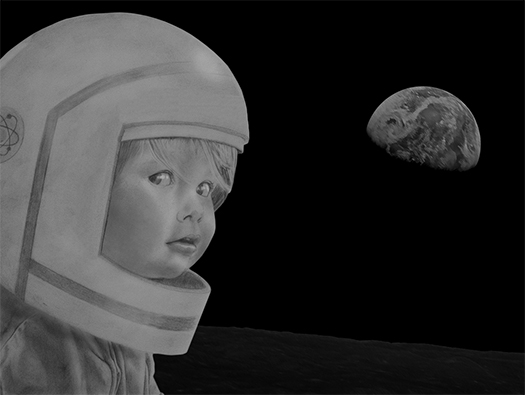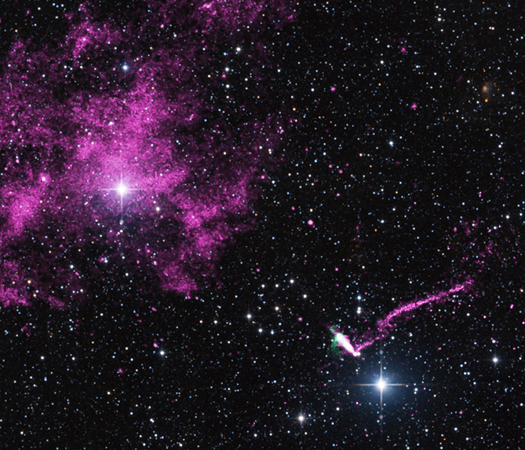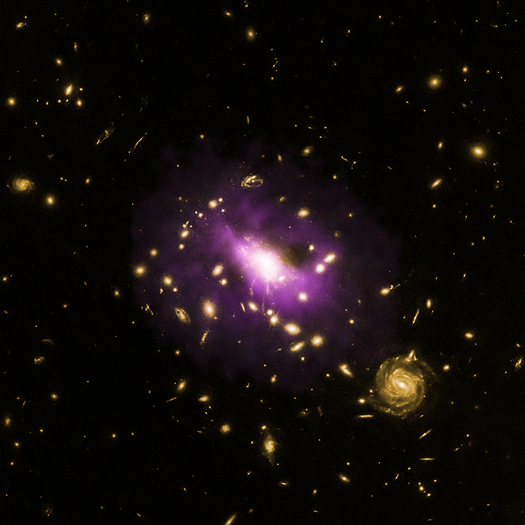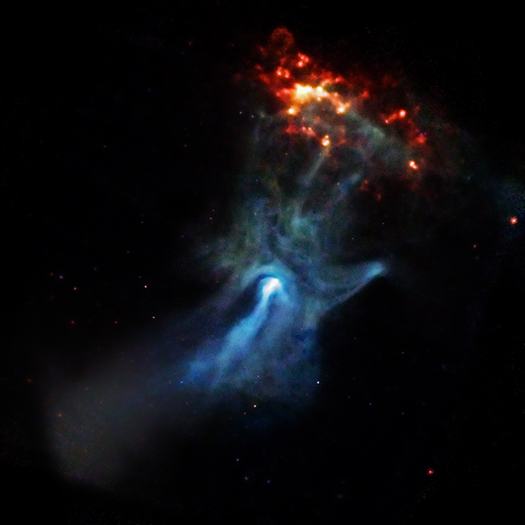Christine Jones Wins Distinguished Smithsonian Honor
We are very proud to announce that the Chandra X-ray Center's Dr. Christine Jones is the recipient of the 2013 Secretary's Distinguished Research Lecture Award from the Smithsonian Institution.
The award recognizes a scholar's sustained achievement in research, long-standing investment in the Smithsonian, outstanding contribution to a field, and ability to communicate research to a non-specialist audience.
Christine has been part of the Chandra family since before "Chandra" even existed. She started her work in the field of X-ray astronomy as an undergraduate at Harvard. With the 1970 launch of Uhuru, the first satellite devoted exclusively to X-ray astronomy, Christine studied Cygnus X-1, a binary X-ray source in which a black hole orbits a normal star.
Runaway Pulsar Firing an Extraordinary Jet
An extraordinary jet trailing behind a runaway pulsar is seen in this composite image that contains data from NASA's Chandra X-ray Observatory (purple), radio data from the Australia Compact Telescope Array (green), and optical data from the 2MASS survey (red, green, and blue). The pulsar - a spinning neutron star - and its tail are found in the lower right of this image (mouse over the image for a labeled version). The tail stretches for 37 light years , making it the longest jet ever seen from an object in the Milky Way galaxy, as described in our press release.
Running at Breakneck Speed With Open Arms

Lucia Pavan graduated with a master thesis in astronomy at the University of Padova (the same town from which Galileo discovered Jupiter's moons). Four years later she also got her PhD in Physics at the same university, working on "magnetars" -a particular kind of pulsars, with the highest magnetic fields. After the PhD, she obtained a postdoc position at the University of Geneva - Switzerland, working at the INTEGRAL Science Data Center (ISDC). In between, she moved to the US, working at University of Wisconsin-Madison for a few months. She currently lives in Geneva, working at the ISDC.
When I started to work on the sources discovered by the INTEGRAL satellite, I didn’t expect to find an object that was extraordinary not only for the properties of its emission, but also for its extension and shape in the sky. And yet this was the case when I came across IGR J11014-6103.
INTEGRAL is an ESA satellite in operation since 2002, sensitive mainly to X-ray and gamma-ray bands. The satellite has been accumulating data since the beginning of the mission, providing information on an always-growing number of X-ray emitters. It is thanks to this ability that new objects are continuously discovered. A large fraction of the sources that INTEGRAL has found still lacks any physical classification, a perfect area for new findings to be done.
The Art of Astrophysics
Recently, a group at MIT's Kavli Institute held a contest called "The Art of Astrophysics". Just this week, they announced the winners. Here's an excerpt of an email from the organizers:

A New Look at an Old Friend
Astronomers have used NASA's Chandra X-ray Observatory and a suite of other telescopes to reveal one of the most powerful black holes known. The black hole has created enormous structures in the hot gas surrounding it and prevented trillions of stars from forming.
Extreme Power of Black Hole Revealed
Astronomers have used NASA's Chandra X-ray Observatory and a suite of other telescopes to reveal one of the most powerful black holes known. The black hole has created enormous structures in the hot gas surrounding it and prevented trillions of stars from forming.
Finding Patterns

Image: Frank Kovalchek, Wikimedia Commons
One of our favorite games to play with our kids is trying to find recognizable objects in clouds as they pass by on a sunny day. One cloud might look like an elephant, the next, a pirate ship.
Blog Posts on a Black Hole Ripping Apart a Star
We are delighted to welcome guest blog posts from Peter Maksym from the University of Alabama and Davide Donato from NASA’s Goddard Space Flight Center (GSFC). These posts give more information about our new press release concerning evidence for a black hole ripping a star apart in a dwarf galaxy. Peter and Davide led two independent studies of this exciting find. We begin with Peter’s blog post.
Doubling Down With Rare White Dwarf Systems
In the middle of the twentieth century, an unusual star was spotted in the constellation of Canes Venatici (Latin for "hunting dogs"). Years later, astronomers determined that this object, dubbed AM Canum Venaticorum (or, AM CVn, for short), was, in fact, two stars. These stars revolve around each other every 18 minutes, and are predicted to generate gravitational waves - ripples in space-time predicted by Einstein.
Getting the Upper Hand on Understanding Neutron Stars
When we released Chandra’s image of the pulsar known as PSR B1509-58 (or, B1509, for short), it received a lot of attention. It's a fascinating object. The pulsar at the center of the image is a rapidly spinning dense star that is spewing out energetic particles into beautiful structures spanning trillions of miles that glow in X-ray light. And, it looks like a giant hand. This fact helped trigger a whole host of other comments about this object found some 17,000 light years from Earth.





